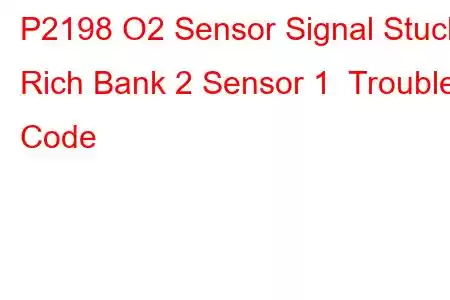P2198 O2 Sensor Signal Biased/Stuck Rich (Bank 2 Sensor 1) Code
OBD-II Trouble Code Technical Description
O2 A/F Sensor Signal Biased/Stuck Rich (Bank 2 Sensor 1)
What does that mean?
This code is a generic powertrain code. It is considered generic because it applies to all makes and models of vehicles (1996-newer), although specific repair steps may be slightly different depending on the model.
On some vehicles, such as Toyotas, this is actually referring to A/F sensors, Air/Fuel ratio sensors. Which are basically more sensitive versions of oxygen sensors.
The powertrain control module (PCM) monitors the air/fuel ratio of the exhaust using oxygen (O2) sensors, and tries to keep things at the normal air/fuel ratio of 14.7:1 via the fuel system. The oxygen A/F sensor outputs a voltage reading that the PCM uses. This DTC is set when the air/fuel ratio as read by the PCM is rich (too much fuel in the mixture) and has strayed so far from 14.7:1 that the PCM can no longer correct it.
This code specifically refers to the sensor between the engine and catalytic converter (not the one behind it). Bank #2 is the side of the engine that does not contain cylinder #1.
Note: This DTC is very similar to P2195, P2196, P2197. If you have multiple DTC codes, always fix them in the order they appear.
Symptoms
For this DTC, the malfunction indicator lamp (MIL) will illuminate. There may be other symtoms such as increased fuel consumption.
Causes
Potential causes of a P2198 code include:
Oxygen (O2) or A/F ratio sensor or sensor heater malfunction Open or short in O2 sensor circuit (wiring, harness) Fuel pressure or fuel injector problem Faulty PCM Intake air or engine vacuum leaks Faulty fuel injector(s) Fuel pressure too high or too low PCV system leak/fault A/F sensor relay faulty MAF sensor malfunction ECT sensor malfunction Air intake restriction Fuel pressure too high Fuel pressure sensor malfunction Fuel pressure regulator malfunction Note on some vehicles that have been modified this code may be caused by the modifications (e.g. aftermarket exhaust, headers, etc.).Diagnostic Steps & Possible Solutions
Use a scan tool to get readings from the sensor, and monitor the short and long term fuel trim values and O2 sensor or Air Fuel Ratio sensor readings. Also, look at the freeze frame data to see the conditions at the time the code was set. That should help determine if the O2 AF sensor is operating correctly. Compare with manufacturers values.
If you don’t have access to a scan tool, you could use a multimeter and back-probe the terminals on the O2 sensor wiring connector. Check for shorts to ground, short to power, open circuits, etc. Compare specs with manufacturers specifications.
Visually inspect the wiring & connectors leading to the sensor, check for loose connectors, wires rubbed/chaffed, melted wires, etc. Repair as necessary.
Visually inspect vacuum lines. You can also test for vacuum leaks using propane or carburetor cleaner along the hoses while the engine is running, if the RPMs change you likely found the leak. Be very careful if doing that, and have a fire extinguisher within reach in case something goes wrong. If a vacuum leak is determined to be the problem, it would be prudent to replace all vacuum lines if they are getting older, becoming brittle, etc.
Use a digital volt ohm meter (DVOM) to check other sensors mentioned such as MAF, IAT, for proper operation.
Perform a fuel pressure test, verify readings against manufacturers specification.
If you’re on a budget and you only have an engine with more than one bank and the problem is only with one bank, you could swap the sensor from one bank to the other, clear the code, and see if the code is followed to the other bank. That would tell you it is the sensor/heater itself that’s failed.
Check for outstanding technical service bulletins (TSB) for your vehicle, in some cases the PCM can be recalibrated to fix this (not a common fix though). TSBs could also call for replacement of the sensor.
When replacing oxygen / AF sensors, be sure to use a high quality ones. In many cases non-OEM sensors are of lesser quality and will not perform correctly. We strongly recommend you stick with OEM brand replacements.
Read: 25


